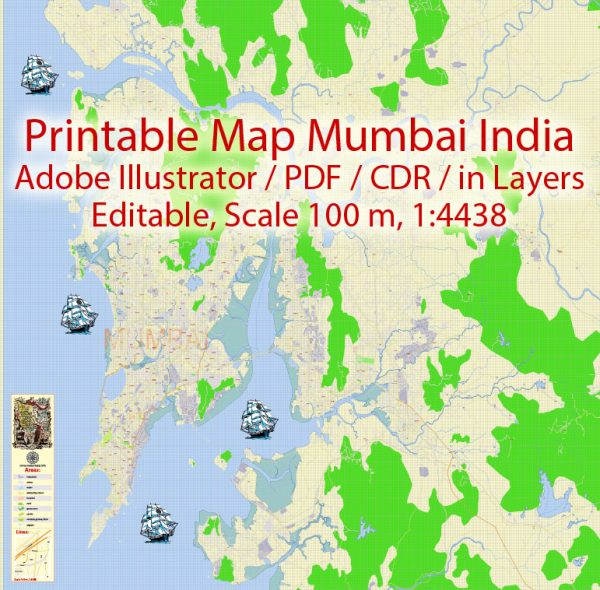Vectormap.Net provide you with the most accurate and up-to-date vector maps in Adobe Illustrator, PDF and other formats, designed for editing and printing. Please read the vector map descriptions carefully.
History of Mumbai:
Mumbai, formerly known as Bombay, has a rich history that dates back to ancient times. The region was originally inhabited by the Koli fishermen, and the islands that constitute present-day Mumbai were ruled by various dynasties, including the Mauryas and Chalukyas. The Portuguese took control of the islands in the 16th century, and later, the British East India Company acquired them as part of the dowry for the marriage of Charles II of England to the Portuguese princess Catherine of Braganza.
Mumbai grew into a major trading port under British rule and witnessed significant development during the 19th century. It played a crucial role in the Indian independence movement and was the birthplace of the Indian National Congress in 1885. After independence in 1947, Mumbai became the capital of the state of Maharashtra.
Port Infrastructure:
Mumbai is home to one of the largest and busiest ports in India, the Mumbai Port Trust (MbPT). The port handles a diverse range of cargo, including containers, bulk cargo, and liquid chemicals. It has numerous terminals, such as the Jawaharlal Nehru Port Trust (JNPT), which is a major container handling port.
JNPT, located on the mainland across the Mumbai Harbour, is a crucial part of the city’s port infrastructure. It is the largest container port in India and plays a pivotal role in international trade.
Transportation Infrastructure:
- Roadways: Mumbai has an extensive road network with well-maintained highways, arterial roads, and expressways. The Mumbai-Pune Expressway is a notable example, connecting Mumbai to Pune.
- Railways: The Chhatrapati Shivaji Terminus (CST) and Mumbai Central are major railway stations in the city. Mumbai’s local train network is the lifeline of the city, transporting millions of people daily. The suburban rail network is one of the most extensive and busiest in the world.
- Metro Rail: Mumbai Metro, with multiple lines under construction and operation, is expanding to ease the burden on the local train network and road traffic.
- Airports: Chhatrapati Shivaji Maharaj International Airport (CSIA) is the primary airport serving Mumbai. It is one of the busiest airports in India and handles both domestic and international flights.
- Sea Link: The Bandra-Worli Sea Link is an iconic cable-stayed bridge that connects the western suburbs of Mumbai with Worli in South Mumbai, reducing travel time between these areas.
- Public Transportation: In addition to local trains and metro, Mumbai has a comprehensive bus network operated by Brihanmumbai Electric Supply and Transport (BEST). Additionally, auto-rickshaws and taxis are widely available for local transportation.
The transportation infrastructure in Mumbai is continually evolving to meet the growing needs of this vibrant and densely populated metropolis.



 Author: Kirill Shrayber, Ph.D.
Author: Kirill Shrayber, Ph.D.